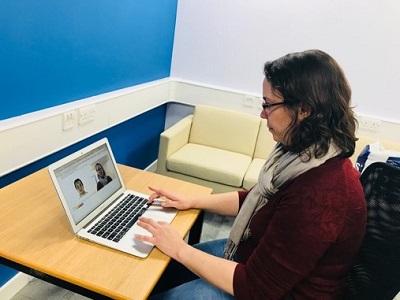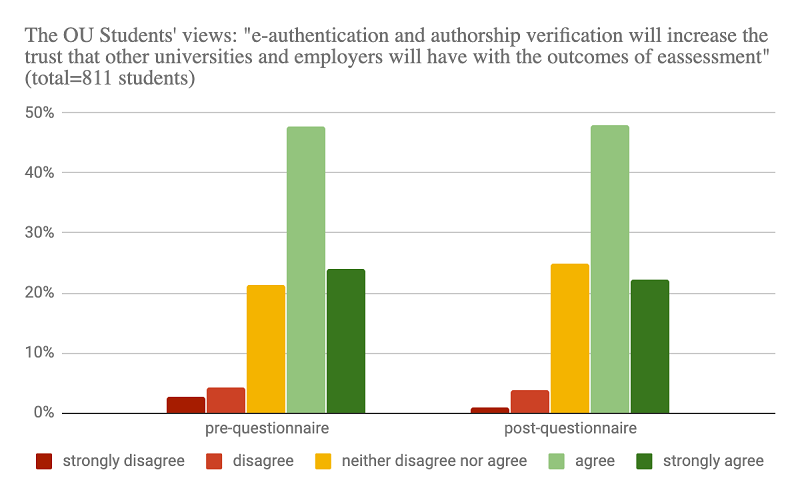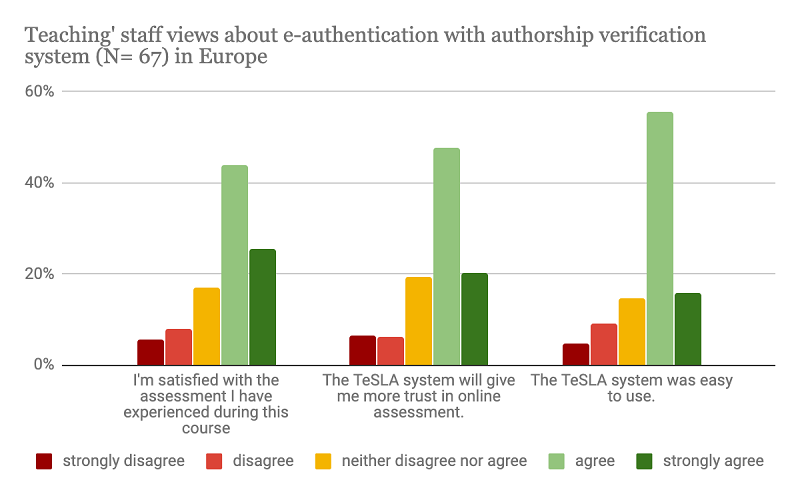In this article, I present the research findings of the e-authentication and authorship verification system for e-assessment TeSLA, which was used by seven institutions in Europe, including the Open University, to enhance academic integrity. I also present teaching staff and students’ views about the benefits of this novel system.
 Figure 1 TeSLA system for Face Recognition
Figure 1 TeSLA system for Face Recognition
E-authentication and authorship verification system for education
TeSLA Adaptive Trust-based e-Assessment System for Learning is a European platform (https://tesla-project.eu) which combines biometrics and textual analysis instruments for authenticating student identity and verifying authenticity of their work. The biometric instruments are:
- Facial Recognition (FR): compares the face and facial expressions using images and videos.
- Voice Recognition (VR): compares voice structures with the learner model.
- Keystroke Dynamics (KD): compares the rhythm and speed of typing when using the keyboard with the learner model.
- Face presentation attack detection (FPAD): detects presentation attacks to the face recognition instrument. It expects a real person in front of the camera and not an image.
- Voice presentation attack detection (VPAD): detects attacks in the voice presentation. It expects a real person talking and not an audio file.
The textual analysis instruments are:
- Plagiarism detection (PL): detects similarities (word‐for‐word copies) between a given set of text documents created by students using text matching. The instrument supports common text, word‐processor and PDF formats. This instrument does not compare the given set with external content on the internet.
- Forensic Analysis (FA): compares the personal writing style to the learner model. The user model is updated over time with submission of new documents.
Academic integrity enhanced by technology
Seven European institutions, including the Open University, conducted studies to support the development of the TeSLA system; these involved more than 22,000 students, including a large number of courses and teaching staff. Our aims were to identify participants’ views about this novel technology in education, and to provide a set of recommendations during its development through a set of pilot studies.
Our research drew primarily on pre- and post-intervention questionnaires completed by a total of 4,058 students, including 330 Special Educational Needs and Disabled students, and 54 teaching staff from the seven TeSLA pilot universities from six European countries. In addition, seven pilot coordinators, seven technical professionals and seven institutional leaders from the partner universities provided extra data through three questionnaires.
Three cross-national studies and final meta-analysis work were underpinned by responsible research and innovation (RRI) to align scientific-technological advances with societal needs and expectations (Von Schomberg, 2011; Stilgoe et al., 2013). This methodological approach enabled the European TeSLA team to plan, deploy and refine a novel system with informed practices for European Higher Education Institutions and Organisations working with online and blended learning.
The benefits for the Open University: teaching and learning
There were more than 1,700 students who used TeSLA e-authentication and authorship verification from diverse courses in various areas, such as Science, Technology, Mathematics, Engineering, Social Sciences, Psychology, Education, Health, Social Care and Wellbeing.
Approximately 70% of the Open University students consider that their degree is of value, with e-authenticated exams, and respected by external stakeholders such as employers (Figure 2). More than 65% of teaching staff in Europe, including from the OU, think that the e-authentication technology is easy to use and enables them to produce a wider variety of authentic assessments. Course teams will be able to promote academic integrity and quality assurance through e-authentication and authorship verification systems for e-assessment (Figure 3).
 Figure 2 Students' views about TeSLA at the OU
Figure 2 Students' views about TeSLA at the OU
 Figure 3 Teaching staff views about TeSLA in Europe
Figure 3 Teaching staff views about TeSLA in Europe
Participants’ views and recommendations
The overall experience with the TeSLA instruments was positive for more than 50% of the students from all partner universities, with more than 70% considering the key advantages of e-assessment with e-authentication to be: 'to ensure that my examination results are trusted' and 'prove that my essay is my own original work'. They highlighted various benefits, such as:
- 'Reliable and fair evaluation'
- 'Location and time independence'
- 'Less stressful and more adapted to my mental problems'
- 'To not have to travel to an examination centre and avoid all the associated logistics (transport, time off, childcare, school pick-up, etc.)'
Various teaching staff also agreed they were satisfied with the TeSLA experience. Pedagogical guidance was useful for them being able to help students during the process of e-authentication and authorship verification. They also indicated various positive outcomes, for example:
- 'It helps to check the authenticity of students’ work'
- 'It will increase trust of e-assessment among universities and employers'
- 'It will help participants trust the outcomes of e-assessment'
The course coordinators selected the instruments based on the assessment contexts and feasibility of use according to the assessment activity. They also presented the benefits of using e-authentication, such as:
- 'It enables new types of assessments'
- 'It is an opportunity for increasing the trust of e-assessment'
- 'It provides new alternatives for students including SEND'
In terms of system accuracy, findings show that some instruments, like PL (plagiarism detection), whose data (text documents) could be easily interpreted by computers, performed well. Instruments that have to process more complex data, such as video and audio, showed a lower rate of accuracy. Therefore, teaching staff will need to check the results of these instruments.
Outcomes from pilots enable participants to highlight some key recommendations about e-authentication with authorship verification. First, students must become more aware of cheating including unintentional plagiarism. They also need to obtain information about how the tools work, including details about data privacy, protection and security. Second, teaching staff need training and early access to the results of e-authentication and authorship verification to check the outcomes. Third, course teams must increase students’ awareness about academic integrity and discuss academic malpractices including plagiarism and cheating. They also need to provide information about data security and privacy to increase students’ willingness to share personal data.
International co-operation beyond Europe
Our research created new opportunities for studies in Brazil through partnerships with various institutions from the COLEARN network, who joined OpenLearn and used TeSLA to provide their views about trust-based e-assessment in the context of non-formal learning and professional development. There were more than 10 institutions in Brazil who collaborated with the OU TeSLA and are now developing new research projects, including their PhD students who are interested in this topic.
Some of these projects are supported by researchers, technologists and end-users including students who consider it important to support responsible research and innovation with technology enhanced e-assessment. These research groups supported by our studies are exploring mixed reality and formative assessment with face recognition (Okada et al., 2019a), opportunities for accreditation of non-formal online learning through trust-based e-assessment (Okada et al., 2019b), and pedagogical strategies to increase academic integrity (Okada et al., 2019c).
The digital revolution for academic integrity has already begun to enhance the quality of teaching and learning outcomes, in particular trust-based assessment, and to support the future generations.
Key References
Okada, A., Rocha, K., Fuchter, S., Zucchi, S. and Wortley, D. (2019a) ‘Formative assessment of inquiry skills for Responsible Research and Innovation using 3D Virtual Reality Glasses and Face Recognition’, Technology Enhanced Assessment. Amsterdam, the Netherlands, 10-11 Dec 2018. Springer [Online]. Available at http://oro.open.ac.uk/58243 (Accessed 20 June 2019).
Okada, A., Whitelock, D., Holmes, W. and Edwards, C. (2019b) ‘e-Authentication for online assessment: A mixed-method study’, British Journal of Educational Technology, 50(2), pp. 861–875 [Online]. Available at http://oro.open.ac.uk/53704 (Accessed 20 June 2019).
Okada, A., Noguera, I., Aleksieva, L., Rozeva, A., Kocdar, S., Brouns, F., Whitelock, D. and Guerrero-Roldán, A-E. (2019c) ‘Pedagogical approaches for e-assessment with authentication and authorship verification in Higher Education’, British Journal of Educational Technology [Online]. Available at http://oro.open.ac.uk/58380 (Accessed 20 June 2019).
Stilgoe, J., Owen, R. and Macnaghten, P. (2013) ‘Developing a framework for responsible innovation’, Research Policy, vol. 42, issue 9, pp. 1568–1580 [Online]. Available at https://www.sciencedirect.com/science/article/pii/S0048733313000930 (Accessed 20 June 2019).
Von Schomberg, R. (2011) ‘Prospects for technology assessment in a framework of responsible research and innovation’, in Dusseldorp, M. and Beecroft, R. (eds) Technikfolgen abschätzen lehren, VS Verlag für Sozialwissenschaften, pp. 39–61 [Online]. Available at https://link.springer.com/chapter/10.1007/978-3-531-93468-6_2 (Accessed 20 June 2019).
Rate and Review
Rate this article
Review this article
Log into OpenLearn to leave reviews and join in the conversation.
Article reviews
CPT Meghnad Bhowmick
US Army Hospital